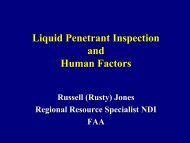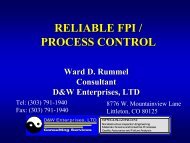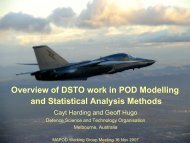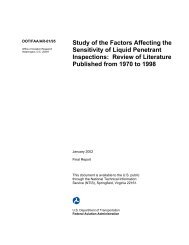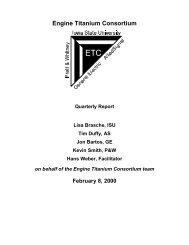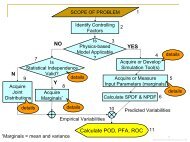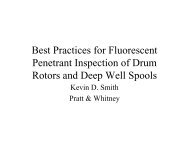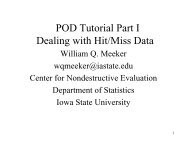Engine Titanium Consortium - Center for Nondestructive Evaluation ...
Engine Titanium Consortium - Center for Nondestructive Evaluation ...
Engine Titanium Consortium - Center for Nondestructive Evaluation ...
You also want an ePaper? Increase the reach of your titles
YUMPU automatically turns print PDFs into web optimized ePapers that Google loves.
Project 3:<br />
Task 3.1:<br />
Subtask 3.1.3:<br />
Inspection Systems Capability<br />
Assessment and Validation<br />
POD Methodology Applications<br />
POD of Eddy Current<br />
Inspections in the Field<br />
Team Members:<br />
HW:<br />
GE: Dick Burkel, Jon Bartos, Shridhar<br />
Nath, Walt Bantz<br />
ISU: Bill Meeker, Norio Nakagawa, Bruce<br />
Thompson<br />
PW: Kevin Smith, Dave Raulerson, Taher<br />
Aljundi<br />
Students: none<br />
Program initiation date: June 15, 1999. All ef<strong>for</strong>t was stopped on March 17, 2000.<br />
Objectives:<br />
• To develop a new methodology <strong>for</strong> estimating the POD and PFA of eddy current (ET)<br />
inspections in the field which facilitates prediction of POD and PFA <strong>for</strong> specific changes in test<br />
parameters, surface conditions, material noise characteristics and feature geometries in a rapid<br />
fashion without the need to construct extensive specimen sets.<br />
• To validate that methodology by comparing its POD results to corresponding predictions of<br />
existing methodologies, such as the a-hat versus a model, when sufficient data exists to<br />
support that comparison.<br />
• To apply the methodology to the estimation of POD/PFA of inservice inspections of flat plates and<br />
slots.<br />
• To transfer the resulting software and procedures to the OEM’s <strong>for</strong> their use in life management<br />
calculations.<br />
Approach:<br />
As in the previous work on UT, the methodology will be based on the determination of the<br />
distributions of signal and of noise, with physical models of the measurement process being used to<br />
allow the maximum in<strong>for</strong>mation to be obtained from limited experimental data. Special emphasis<br />
will be placed on the needs imposed by the development of field durability issues.<br />
The incorporation of physical models of the inspection adds flexibility and extensibility to the<br />
methodology, while reducing the cost. In general, physical models make parametric studies<br />
inexpensive, by repeated computations of output signals <strong>for</strong> a wide range of inspection parameters.<br />
The specific benefits of the models used in POD/PFA analyses are twofold:<br />
• The model-assisted POD/PFA estimation significantly reduces the specimen preparation,<br />
compared to a purely experiment-based POD estimate. The economic benefit is substantial <strong>for</strong><br />
flat-surface geometry since only a handful of crack specimens are sufficient to provide<br />
normalization and model predictions can then cover a wide range of parameters. The benefit is<br />
even more substantial when complex geometries are considered because, without models, one<br />
Quarterly Report – January 1, 2002 –March 31, 2002<br />
print date/time: 6/6/2002 - 8:39 AM – Page 106



